Vought XF5U/V-173 "Flying Pancake"
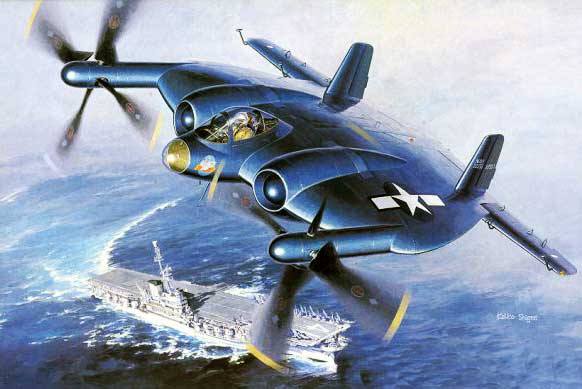
It is a great disappointment that the Vought XF5U-1 never flew. When a test prototype, the V-173, took to the air it was unique. The V-173 and the XF5U-1 fighter were based upon a wing of circular shape, which was also the 'fuselage'.
Designed to be capable of vertical take-off and landing, as well as very high-speed flight, the 'Flying Pancake' used a very low aspect ratio wing offering high efficiency. This design was the brainchild of Charles Zimmerman, who had been researching such shapes since 1933. The wood-and-fabric V-173 performed well in tests during 1942, proving stall-proof.
The all-metal XF5U-1 fighter, which used the same wing planform, would have gone further despite problems with its complex transmission. But, although the XF5U-1 was shipped to Muroc, California, for tests, it never flew. The jet age made propeller-driven fighters a thing of the past and the XF5U was scrapped.
Vought "Flying Pancake", "Flying Saucer", "Flying Flapjack", XF5U-1/V-173
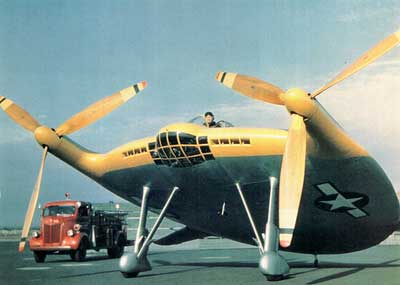 The "flying saucer" which thousands of Americans saw in the sky in 1943, near Stratford, Connecticut was no extraterrestrial visitor or mysterious UFO; it was Vought's Model V-173 making one of its 200 or more test flights with Boone T. Guyton or Richard Burroughs or even, on occasion, Charles Lindbergh, at the controls. This was one or the strangest looking flying machines to take to the air since the early pioneering days, but was actually a revolutionary new plane which was built as an experimental fighter, following certain principles of Aerodynamics which its designer, Charles H. Zimmermann had been waiting for the chance to demonstrate since 1933.
The "flying saucer" which thousands of Americans saw in the sky in 1943, near Stratford, Connecticut was no extraterrestrial visitor or mysterious UFO; it was Vought's Model V-173 making one of its 200 or more test flights with Boone T. Guyton or Richard Burroughs or even, on occasion, Charles Lindbergh, at the controls. This was one or the strangest looking flying machines to take to the air since the early pioneering days, but was actually a revolutionary new plane which was built as an experimental fighter, following certain principles of Aerodynamics which its designer, Charles H. Zimmermann had been waiting for the chance to demonstrate since 1933.
Zimmermann's research had led him to design an aircraft of almost circular plan form with large propellers driven by powerful engines; this plane was able to take off and land within very restricted spaces, to hover at very low speeds or while stationary yet it could also reach higher speeds than any existing conventional aircraft. This seemed to make it ideally suited for carrier-based use.
Zimmermann joined Vought in 1937, at the invitation of the company's president, Eugene E. Wilson and awakened the Navy's interest in the project by giving a demonstration with a radio controlled model. In 1941, Vought started work on a low-powered full scale version in wood and fabric for experimental use. Model V-173 made its first flight, lasting 13 minutes with Boone T. Guyton at the controls on November 23, 1942, taking off from Bridgeport airport. Tested for a total of 131 hours, this full-scale model proved Zimmermann's theories to be broadly correct as it managed to make short take- offs, reached relatively high speeds (taking the restricted power of the small engines in account), and handled well, being impossible to stall or put into a spin.
On July I5, 1944, the U.S.Navy ordered two fully powered prototypes of the final working model version, the VS-315, designating them XF5U-1. These were very similar to the V-173 but of metal construction, using a large proportion of metalite, a very thin sheet of balsa wood sandwiched between to layers of very strong aluminum, forming the skin. Two 1,350hp Pratt & Whitney R-2000-7 engines were buried in the "wing" on either side of the cockpit, cooled by air inlets on the leading-edge and driving two large four-bladed propellers with articulated blades like those of a helicopter, through a complicated transmission system. 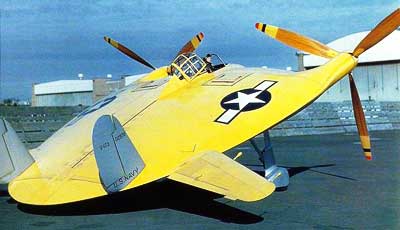
The control surfaces consisted of twin fins and rudders and between them were sited wide flaps; all moving horizontal tail planes and elevators were sited outboard of the vertical tailplanes, jutting out from the edge of the main structure. The retractable landing gear was unusually high. The XF5U-l was completed in August, 1945, but it was 1947, before the specially built propellers were ready and tethered tests continued through 1948. The inaugural flight was to take place at Edwards AFB where facilities could cope with any complications which might arise, especially with the intricate engine-propeller transmission system.
This would have entailed transporting the prototype by ship through the Panama Canal from Connecticut to California. The U.S.Navy was impatient of all the delays which had occurred and by then the jet era had arrived, making the authorities wary of committing themselves to a piston-engined project; the defense budget had also been cut.
On March 17, 1949, the program was terminated and orders issued to scrap the XF5U-l before it made its first flight. This aircraft, popularly known as "Zimmer's Skimmer" or "The Flying Pancake" is still, with the V -173, one of the most interesting and revolutionary developments of the 1940s. It is a pity that the final prototype never flew, to see whether its inventor's totally fresh approach would have been fully vindicated.
Call it what you may, "Flapjack," "Saucer," "Pancake;" it had no official name, but Vought's last propeller-driven fighter would certainly answer to "weird." Initial planning for the odd craft actually began in 1938, when a patent was obtained for an airplane of generally circular planform. The designer was Charles H. Zimmerman, an engineer for NACA.
Tests of scale models indicated that an airplane using large-diameter propellers and Zimmerman's circular wing would have the ability to take-off and land vertically as well as hover in the air, yet be able to flash away at a speed of over 500 mph. In 1939, plans for full-size flying model were presented to the Navy by Vought, who now employed Zimmerman. Interested in the concept, the Navy submitted the idea to N ACA and requested wind tunnel data on the radical proposal.
These tests also indicated a remarkable performance potential so the Navy authorized the construction of the full-scale flying model to further evaluate the unique characteristics of the proposed aircraft. This model was designated V-173, assigned BuNo 029781, and was constructed of wood covered with fabric. Two 80 hp Continental A-80 engines were used to drive a pair of 16 foot 6 inch wooden propellers.
The V -173 weighed 2,- 258 pounds; and in keeping with the Navy colors of the day, was painted chrome yellow on top and silver on the bottom. The V -173 made a rather hairy first flight on November 23, 1942. The low-powered engines could barely keep the craft in the air and the stick forces were extremely heavy and performance sluggish; but it took off in about 50 feet and landed in an equally short distance. Flying of the V -173 continued with the shortcomings being corrected as the tests proceeded. In the meantime, Vought engineers were drawing up the plans for the definitive combat weapon which received the official designation XF5U-l from the Navy.
The V -173 proved to be virtually stallproof. At no time would the plane ever stall or spin during the tests, no matter how tight the turn. Maximum speed of the craft was 138 mph and it could climb 5,000 feet in 7 minutes. The specifications for the XF5 U-1 fighter were truly exciting considering the performances being achieved by the typical 1942 fighter. With a pair of 1,600 hp Pratt & Whitney R-2000-7 air-cooled waterinjected engines, the maximum speed was to be 460 mph while the landing speed was to be as low as 20 mph. Projecting even further, a pair of gas turbines could provide a speed of 550 mph while landing at near zero ground speed. With the turbine powerplant, the XF5 U-1 would actually hover motionless in the air, hanging under its props like a helicopter. The Navy ordered two XF5U-1's as the V-173 flights proceeded. One was to be used for static testing while the second would be used for flight evaluation.
Even the construction of the strange fighter was unconventional. To keep the weight as low as possible, the skin was formed of aluminum laminated to a balsa core, a material called Metalite and developed by Vought. The two engines were located on either side of the cockpit with fans drawing air from the inlets and forcing it over the powerplants. Drive shafts extended outward at right angles toward the propeller shafts on each side, where a second gear box directed the power forward to the props.
The blades were specially constructed of wood and mounted in two vertical planes. Each propeller blade was articulated and could tilt fore and aft of its connections on the shaft. This is similar to the movements of the rotors on a helicopter, to which the XF5U-1 seemed a second cousin. The control system of the XF5U-1 consisted of a pair of conventional vertical stabilizers on the symmetrical airfoil. Between these were two stability flaps. Pitch and roll were achieved with a pair of ailavators - combination ailerons and elevators located on the edges of the wing like body.
The cockpit featured an ejection seat, and access was by means of a series of steps built into the right top of the body. The arresting gear was also on top of the body. An actuator pushed the forward edge of the assembly upward and slid the hook to the rear and below the trailing edge of the body. The proposed armament was six .50 cal. machine guns or four 20 mm cannons. Two 1,000 pound bombs could be suspended under the body. The lifting surface had a span of 23 feet 4 inches with an area of 475 square feet.
The ailavator span was 32 feet 6 inches, but the overall width of the machine, measured to the tips of the propellers, was 36 feet 5 inches. Length of the strange fighter was 28 feet 1 inch and height was 16 feet 8 inches. Empty weight was 13,107 pounds, gross was 16,722 pounds. It was anticipated that the XF5U-1 would have a climb rate of 3,590 fpm with a service ceiling of 34,500 feet. With 300 gallons of fuel, the range was to be 710 miles.
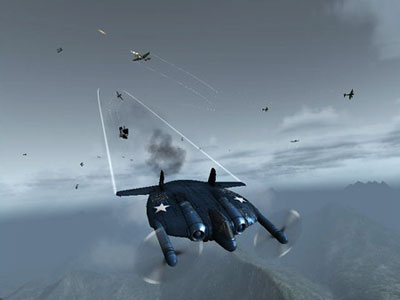 The prototype of the unique fighter was completed and prepared for engine testing on August 20, 1945. For the initial run-ups, a pair of Corsair propellers were installed; but they were not satisfactory for flight. The articulated propellers were not available until 1947, when taxiing tests were finally undertaken. During one of these tests, the big blue "flapjack" actually lifted off the runway.
The prototype of the unique fighter was completed and prepared for engine testing on August 20, 1945. For the initial run-ups, a pair of Corsair propellers were installed; but they were not satisfactory for flight. The articulated propellers were not available until 1947, when taxiing tests were finally undertaken. During one of these tests, the big blue "flapjack" actually lifted off the runway.
Full flight tests were scheduled for December 1948, and Vought had decided that the safest place to fly their radical machine was at the Air Force Flight Test Center, now known as Edwards Air Force Base. Because of its shape, it would be necessary to transport the plane by boat from Connecticut through the Panama Canal to California. Before this event could take place, the Navy had reconsidered its position in the development of a piston-powered airplane at a time when jet propulsion was showing its greater potential as a power unit.
On March 17, 1949, the contract was cancelled with orders to destroy the sole prototype - the static test vehicle had already gone that route. The XF5 U-1 was so sturdy that even a steel ball dropped from a crane only bounced off the body. Finally, the ball was dropped between the spars, falling through the structure to the ground; then blowtorches were used to reduce the bold experiment to rubble.
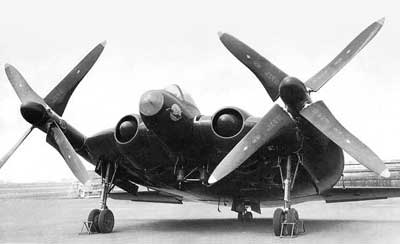 |
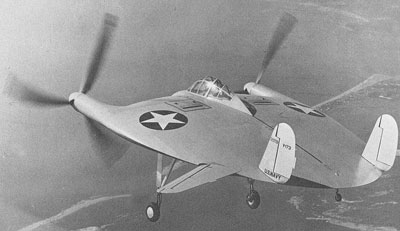 |
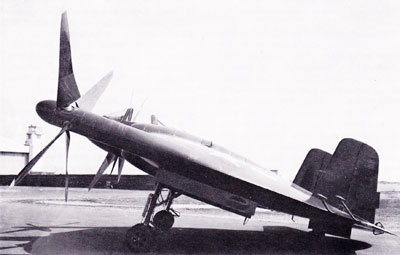 |
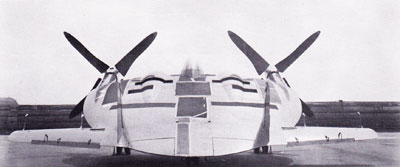 |
Specifications for the Vought V-173 "Flying Flapjack"
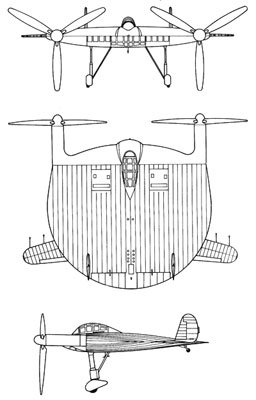 |
Length: 26 ft 8 in Wingspan: 23 ft 4 in Height: 14 ft 9 in Wing area: 475 ft² Loaded weight: 2,258 lb Powerplant: 2× Continental A-80 inline engine, 80 hp each Performance Maximum speed: 138 mph Rate of climb: to 5,000 ft in 7 min (1,100 m in 5 min) |
Specifications for the Vought XF5-1 "Flying Pancake"
Length: 28 ft 7 in Wingspan: 32 ft 6 in Height: 14 ft 9 in Wing area: 475 ft² Empty weight: 13,107 lb Loaded weight: 16,722 lb Max takeoff weight: 18,772 lb Powerplant: 2× Pratt & Whitney R-2000-7 radial engine, 1,350 hp each Performance Maximum speed: 475 mph at 28,000 ft (estimated) Range: 1,064 miles Service ceiling: 34,492 ft Rate of climb: 3,000 ft/min Wing loading: 35 lb/ft² Power/mass: 0.16 hp/lb Armament 6 × .50 machine guns or 4 × 20 mm machine guns or 2 × 1000 lb. bombs |
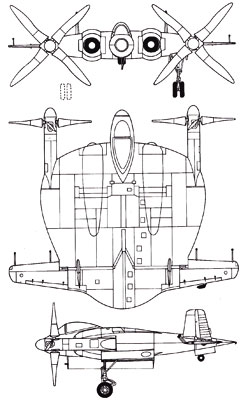 |
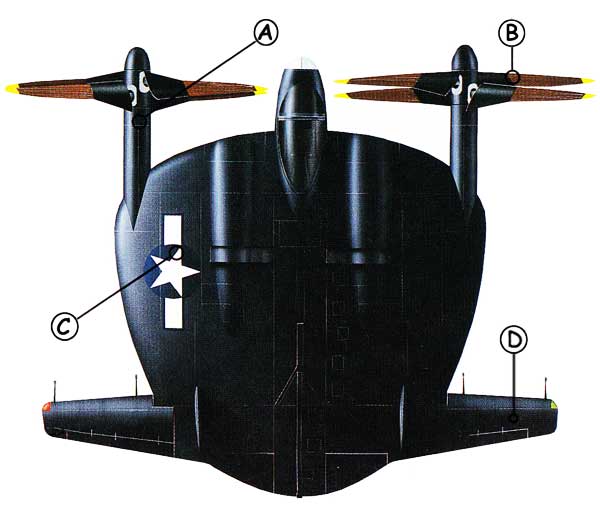 |
|||
| A: The engines were fitted inside the blended wing and fuselage and drove the propellers via shafts. | B: Propeller technology was of vital importance to the XF5U because of Its large range of speed and its hovering requirement. | C: The contra-rotating propwash over the wingtip prevented the formation of wingtip vortices, thereby reducing induced drag to very low levels. | D: The massive propwash close to the large tail gave the XF5U very good control authority. |
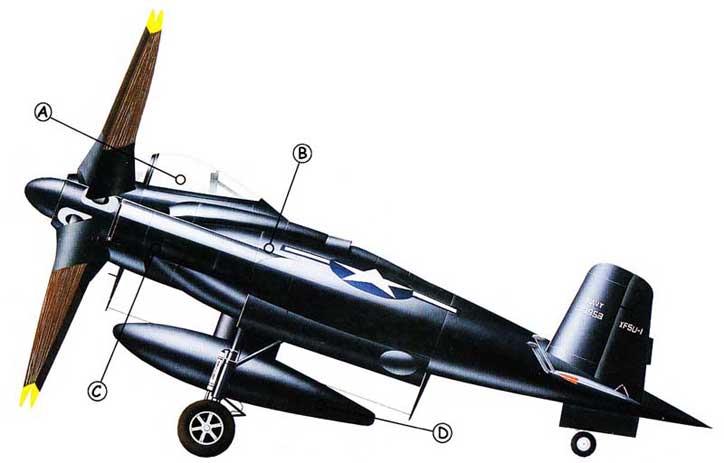 |
|||
| A: An ejection seat was provided for the pilot. The cockpit contained a special propeller control lever and the canopy opening was electrically operated. | B: Either engine could drive both shafts in an emergency. The complexity of such a system, with right-angled drives, clutches and five-to-one reduction gearboxes, caused huge problems. | C: Projected gun armament either side of the cockpit was not fitted. A combination of machine guns and 20-mm cannon would have been used. | D: Provision was made for the XF5U to carry two drop-tanks under the inner fuselage. |
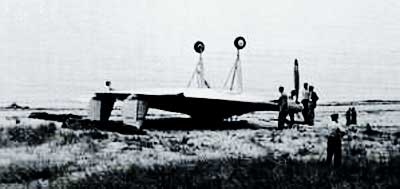 |
While the V-173 flew some 130+ flights, not all ended in a clean landing... |

